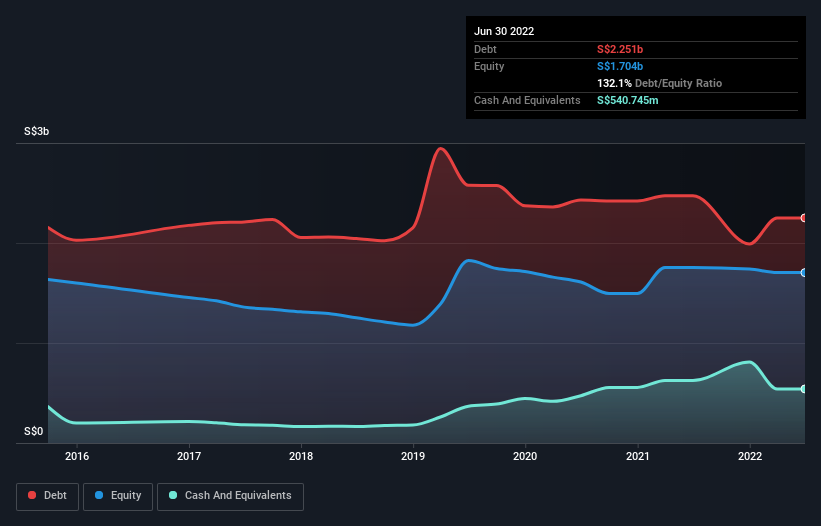Keppel Infrastructure Trust (SGX:A7RU) Takes On Some Risk With Its Use Of Debt
The external fund manager backed by Berkshire Hathaway's Charlie Munger, Li Lu, makes no bones about it when he says 'The biggest investment risk is not the volatility of prices, but whether you will suffer a permanent loss of capital.' So it seems the smart money knows that debt - which is usually involved in bankruptcies - is a very important factor, when you assess how risky a company is. Importantly, Keppel Infrastructure Trust (SGX:A7RU) does carry debt. But is this debt a concern to shareholders?
What Risk Does Debt Bring?
Generally speaking, debt only becomes a real problem when a company can't easily pay it off, either by raising capital or with its own cash flow. In the worst case scenario, a company can go bankrupt if it cannot pay its creditors. However, a more usual (but still expensive) situation is where a company must dilute shareholders at a cheap share price simply to get debt under control. Of course, debt can be an important tool in businesses, particularly capital heavy businesses. When we examine debt levels, we first consider both cash and debt levels, together.
View our latest analysis for Keppel Infrastructure Trust
What Is Keppel Infrastructure Trust's Net Debt?
As you can see below, Keppel Infrastructure Trust had S$2.25b of debt at June 2022, down from S$2.47b a year prior. However, because it has a cash reserve of S$540.7m, its net debt is less, at about S$1.71b.

A Look At Keppel Infrastructure Trust's Liabilities
We can see from the most recent balance sheet that Keppel Infrastructure Trust had liabilities of S$521.6m falling due within a year, and liabilities of S$2.45b due beyond that. Offsetting these obligations, it had cash of S$540.7m as well as receivables valued at S$351.8m due within 12 months. So it has liabilities totalling S$2.08b more than its cash and near-term receivables, combined.
This deficit is considerable relative to its market capitalization of S$2.70b, so it does suggest shareholders should keep an eye on Keppel Infrastructure Trust's use of debt. This suggests shareholders would be heavily diluted if the company needed to shore up its balance sheet in a hurry.
In order to size up a company's debt relative to its earnings, we calculate its net debt divided by its earnings before interest, tax, depreciation, and amortization (EBITDA) and its earnings before interest and tax (EBIT) divided by its interest expense (its interest cover). Thus we consider debt relative to earnings both with and without depreciation and amortization expenses.
Keppel Infrastructure Trust shareholders face the double whammy of a high net debt to EBITDA ratio (6.0), and fairly weak interest coverage, since EBIT is just 1.7 times the interest expense. The debt burden here is substantial. However, one redeeming factor is that Keppel Infrastructure Trust grew its EBIT at 10% over the last 12 months, boosting its ability to handle its debt. There's no doubt that we learn most about debt from the balance sheet. But ultimately the future profitability of the business will decide if Keppel Infrastructure Trust can strengthen its balance sheet over time. So if you want to see what the professionals think, you might find this free report on analyst profit forecasts to be interesting.
Finally, a business needs free cash flow to pay off debt; accounting profits just don't cut it. So we clearly need to look at whether that EBIT is leading to corresponding free cash flow. Happily for any shareholders, Keppel Infrastructure Trust actually produced more free cash flow than EBIT over the last three years. There's nothing better than incoming cash when it comes to staying in your lenders' good graces.
Our View
Neither Keppel Infrastructure Trust's ability handle its debt, based on its EBITDA, nor its interest cover gave us confidence in its ability to take on more debt. But its conversion of EBIT to free cash flow tells a very different story, and suggests some resilience. We should also note that Gas Utilities industry companies like Keppel Infrastructure Trust commonly do use debt without problems. We think that Keppel Infrastructure Trust's debt does make it a bit risky, after considering the aforementioned data points together. That's not necessarily a bad thing, since leverage can boost returns on equity, but it is something to be aware of. The balance sheet is clearly the area to focus on when you are analysing debt. However, not all investment risk resides within the balance sheet - far from it. These risks can be hard to spot. Every company has them, and we've spotted 3 warning signs for Keppel Infrastructure Trust (of which 2 are a bit concerning!) you should know about.
If you're interested in investing in businesses that can grow profits without the burden of debt, then check out this free list of growing businesses that have net cash on the balance sheet.
Valuation is complex, but we're here to simplify it.
Discover if Keppel Infrastructure Trust might be undervalued or overvalued with our detailed analysis, featuring fair value estimates, potential risks, dividends, insider trades, and its financial condition.
Access Free AnalysisHave feedback on this article? Concerned about the content? Get in touch with us directly. Alternatively, email editorial-team (at) simplywallst.com.
This article by Simply Wall St is general in nature. We provide commentary based on historical data and analyst forecasts only using an unbiased methodology and our articles are not intended to be financial advice. It does not constitute a recommendation to buy or sell any stock, and does not take account of your objectives, or your financial situation. We aim to bring you long-term focused analysis driven by fundamental data. Note that our analysis may not factor in the latest price-sensitive company announcements or qualitative material. Simply Wall St has no position in any stocks mentioned.
About SGX:A7RU
Proven track record average dividend payer.
Market Insights
Community Narratives



